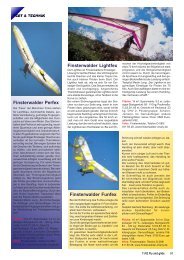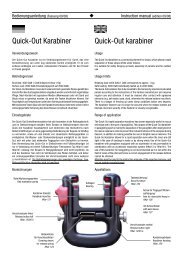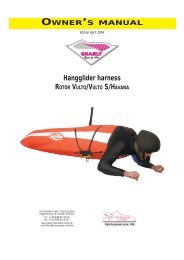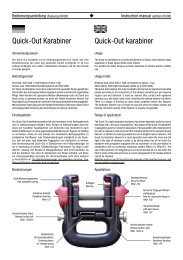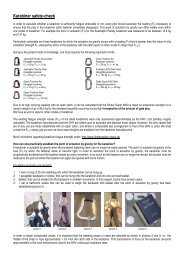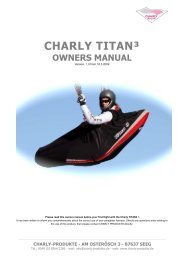Create successful ePaper yourself
Turn your PDF publications into a flip-book with our unique Google optimized e-Paper software.
1.1 TECHNICAL DESCRIPTION<br />
• The double <strong>Charly</strong> Inflate System for increased pilot safety – tested in accordance with the<br />
new certification norm. Rapid inflation in all seating positions due to the asymmetrical<br />
arrangement of the bilateral valve systems, with integrated flaps for optimised inner pressure<br />
and record-breaking shock absorption values even when the system is only half inflated.<br />
• Innovative and technical design of the harness geometry, compatible with all classes of<br />
paraglider<br />
• Perfect seating comfort in all pilot positions with many adjustment possibilities<br />
• Integrated rescue reserve container, can be individually suited to the various packing<br />
volumes of prevalent rescue systems.<br />
• Complete serial fitting with Finsterwalder P-Lock automatic light-weight components<br />
• Practical mountaineering - and travel backpack, suitable for all prevalent paraglider sizes,<br />
integrated in the <strong>Charly</strong> Globe<br />
• Very good compromise between minimalism, low weight, carrying comfort and removable hip<br />
strap for cable-car-only pilots.<br />
Intended purpose Paraglider harness<br />
Maximum certified launch weight: 120kg<br />
weight: 4,4 kg (size. M - without karabiners)<br />
Suspension height: 44 cm<br />
Protector: <strong>Charly</strong> impact pressure protector<br />
LTF-crash test: 19 G<br />
LTF-certification EAPR-GZ-7106/08<br />
Rescue reserve: Integrated container below the seating board<br />
Side deployment handle<br />
1.2 SAFETY<br />
<strong>Charly</strong> presents the world novelty C.I.S. in the field of protectors.<br />
Stand der Technik bei konventionellen Protektoren - Original commentary of the EAPR test<br />
centre:<br />
“The intake and outlet valves are problematic by almost all impact pressure protectors. Many<br />
protectors have good findings as long as they are fully inflated, but loose pressure too quickly (the<br />
intake openings have insufficient valve control)when a collision occurs. We have already been<br />
working with a harness manufacturer for 5 months on the optimising of the impact pressure protector<br />
and have now had a breakthrough.<br />
For the first time we have been able to test an impact pressure protector that exhibits the same good results (+-0,5 G) in a fully inflated<br />
condition, as well as after a 3-5 second approach flow interruption. The present intermediary results are a real advancement from a<br />
technical point of view.“<br />
4





